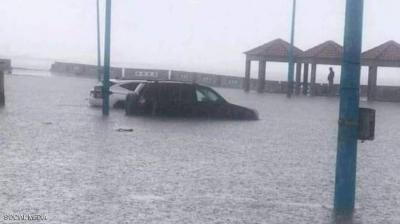The Egyptian Meteorological Authority revealed on Saturday evening the truth behind the strange phenomenon that occurred in Alexandria during a period of instability, which involved a sudden downpour of water from gigantic clouds, known as "downdraft." The official Facebook page of the Egyptian Meteorological Authority stated that "personal and public social media pages have circulated news in recent days about a strange phenomenon that occurred in Alexandria during the recent instability, involving a sudden quantity of water falling from giant clouds that formed there, which is different from the usual rain, and everyone questioned what this phenomenon was."
It added that "this phenomenon is downdraft. It rarely occurs, but it happened in Alexandria due to the massive cumulonimbus clouds affecting the area, accompanied by heavy rainfall." It clarified that "the downdraft phenomenon can be defined as the sudden discharge of water from the cloud, falling as a single mass."
The statement continued: "Rain falls vertically over a specific area in a concentrated manner and occurs when a column of cold air descends within a heavy thunderstorm cloud, accompanied by the phenomenon known as microburst." The Egyptian Meteorological Authority provided the scientific explanation for this phenomenon, stating: "As thunderstorm clouds develop, water droplets or hail within the cloud are suspended or carried by rising air currents. Sometimes, the updraft is so strong that it carries large amounts of droplets and hail to the upper parts of the thunderstorm cloud, where the updraft suddenly cools down, leading to a collapse and descent towards the ground."
It added, "Since cold air is denser, it becomes heavy, thus starting to fall. If this process occurs quickly and over a sufficiently large area, we will have a large column of cold air rapidly descending towards the ground and spreading out forcefully, resembling a small explosion."
The Authority noted that "during the downdraft phenomenon, the generated wind speeds can reach up to 270 km/h. This small surge may also bring rain with it, often referred to as a rain bomb, which is what we witnessed."
It concluded: "The microburst can cause damage to people and buildings, but most of the damage caused is more significant to aircraft."




